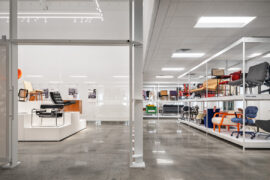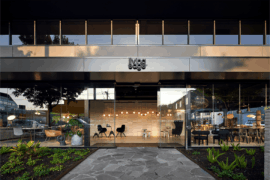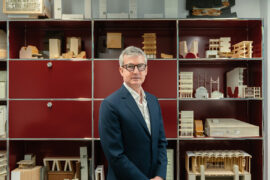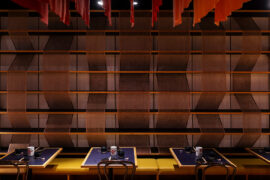Along with chairs, the Salone del Mobile has become synonymous with extravagant installations. Here is the top 6 from this year.

April 20th, 2018
Palazzo Litta continues to grow in scale and this year was no different. The central courtyard of the old palace was taken over by an installation by UK studio Asif Khan.
Tempietto nel Bosco is a wood-based installation, creating a red forest-like environment surrounded by a Renaissance structure. Geometric in shape and oversized in scale, the structure creates a cocooning effect while maintaining a high level of porosity.
–
The Italian masters of intricate and elaborate (yet somehow eerily realistic) design is, of course, Dimore Studio. For this year’s Salone the duo put on not one but three installations across Milan.
A stand out being Transfer, which is a homage to 20th-century masters. As a city of historical relevance for design, the installation unfolds with rooms within rooms. Each space transforms into different mises en scenes and is layered with various trinkets and objects.
–
Creating a site-specific installation, the Swarovski Crystal Palace brings to life the brands décor collection. Set within a hidden courtyard of a Milanese palazzo, the installation plays up to its surrounds.
Some heavyweight collaborators include John Pawson, Patricia Urquiola, Nendo and Peter Pilotto.
–
Set within the Istituto dei Ciech, WonderGlass’ installation titled Kosmos is all about the celebration of glass as a material. Bringing a selection of high profile designers on board, the exhibition looks at innovation in the product.
The Bourallec brothers and Fornasetti each approached the project differently, making for an interesting and varied result despite the same material being used.
–
As one of the established furniture brands with an impressive archive of work, Vitra created a highly curated exhibition of over 200 objects. Robert Stadler designed the show, creating a series of four distinct personalities – each exploring how social change and innovation are changing people’s lives.
The sports stadium, replete with overhead podium/viewing dock only added to the voyeuristic feel.
–
Using high-end food as a way to communicate a clear message, Japanese homeware brand MUJI put on a unique display of food, art and design. Yoji Tokuyoshi, who is a Milan-based chef and the protégé of the famed Massimo Bottura, created The Floating Forest. Partly food and partly art, The Floating Forest is a hanging artwork of moss, plants and bulbs.
Follow @indesignlive and #milanindesign on Instagram for regular Milan Furniture Fair updates.
INDESIGN is on instagram
Follow @indesignlive
A searchable and comprehensive guide for specifying leading products and their suppliers
Keep up to date with the latest and greatest from our industry BFF's!

The undeniable thread connecting Herman Miller and Knoll’s design legacies across the decades now finds its profound physical embodiment at MillerKnoll’s new Design Yard Archives.

For Aidan Mawhinney, the secret ingredient to Living Edge’s success “comes down to people, product and place.” As the brand celebrates a significant 25-year milestone, it’s that commitment to authentic, sustainable design – and the people behind it all – that continues to anchor its legacy.

DKO’s Koos de Keijzer and Michael Drescher bring us this personal report from Salone del Mobile 2025 in Milan.

The esteemed Italian brand has collaborated with Yusuke Kawai to create Kawara, a lighting collection defined by adaptability, elegance and a touch of tradition.
The internet never sleeps! Here's the stuff you might have missed

Leading by design, Erik L’Heureux has recently taken the helm of Monash University’s Department of Architecture, and so a new and exciting journey begins for both L’Heureux and the University.

Designed by Kelly Ross, the newest addition to Bisa Hospitality’s portfolio represents more than just another restaurant opening.